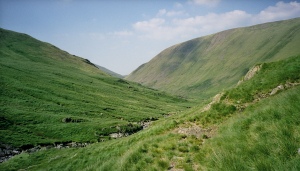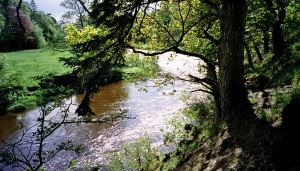An exploration of the imaginative links between John Buchan and the Upper Tweed Valley
Notes and selected bibliography relating to Alastair Learmont’s talk, John Buchan: a Man and His landscape, delivered to the Corstorphine Literary and Geographical Society on Monday 3rd February 2014:
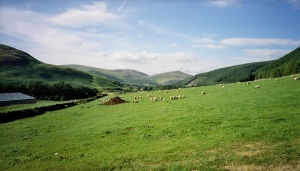
General Biographical Reading:
- Buchan, Anna: Unforgettable Unforgotten, London, 1945 (sister – “Olivia Douglas”)
- Buchan, John: Memory Hold the Door, London, 1940 (lyrical on Borders)
- Buchan, William: John Buchan, A Memoir, London, 1982 (brother)
- Lownie, Andrew: The Presbyterian Cavalier, London, 1995
- Smith, Janet Adam: John Buchan, London, 1965
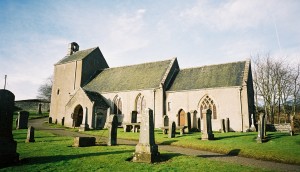
Borders Novels:
- Sir Quixote of the Moors (1895): covenanting background (17C); Galloway based; very early; a short (30,000 word) novel; republished 2008.
- John Burnet of Barns (1898): covenanting during the Killing Times (1680s); much of action set near Peebles and Dawyk; JB draws on folklore and local names; wonderful chase sequences crossing the Tweed and Clyde valleys (OS maps are helpful!)
- Lost Lady of Old Years (1899): JB’s Jacobite Novel draws on historical characters including Charles Edward Stuart
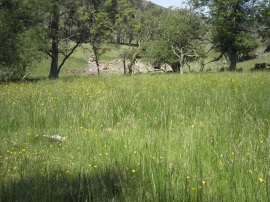 (echoes of Waverley); Broughton is a pivotal setting; its hero, Francis Birkenshaw, gets caught up in the aftermath of Culloden.
(echoes of Waverley); Broughton is a pivotal setting; its hero, Francis Birkenshaw, gets caught up in the aftermath of Culloden.
- The Half Hearted (1900); contemporary novel linking country house life with affairs of state; its hero, Lewis Haystoun is inspired by Raymond Asquith, step grandson of Sir Charles Tenant of the Glen; novel partly set in the Borders; landscape evokes Traquair, the Glen and the Tweed Valley cf Haystoun Estate near Peebles.
- The Thirty -Nine Steps (1915); a “shocker”; chase across SW Scotland; can be traced to Upper Tweed Valley; scope for happy, though perhaps inconclusive, detective work.
- Witch Wood (1927): ; set at time of Philiphaugh(1645); enables JB to introduce his hero, the Marquis of Montrose; idealist y
 oung minister pitched against extremism and witchcraft; a moderate at time of extremes; Woodilee based on Broughton: Kirk Aller is Peebles; Neidpath Castle becomes Calidon Tower; JB’s favourite novel.
oung minister pitched against extremism and witchcraft; a moderate at time of extremes; Woodilee based on Broughton: Kirk Aller is Peebles; Neidpath Castle becomes Calidon Tower; JB’s favourite novel.
Short stories include On Cademuir (1896) and the Black Fishers (1899); Andrew Lownie has edited a complete collection of short stories in 2 vols Poetry: The Fishers (classical inspiration); Collected Poems, ed Andrew Lownie and William Milne, Aberdeen, 1996;
Historical Material: JB’s historical biographies include Montrose (1928) and Sir Walter Scott (1932). He made a significant contribution to his brother, Walter’s Peeblesshire (1925/27)
John Buchan Society: http://www.johnbuchansociety.co.uk/; Museum now in Peebles.
John Buchan
A thumbnail sketch of an extraordinary life
- Scholar, journalist, publisher, barrister, soldier, administrator, politician and statesman
- Prolific author of essays, short stories, poetry, historical novels (romances), historical biography, memoirs, children’s’ books and “shockers”
1875: Born 26th August in Perth
JB’s father John is a Free Church minister. Both his grandfather, John, and Uncle William were Town Clerks of Peebles. JB’s mother, Helen Masterton, is the daughter of a farming family from Broughton. JB is the eldest of five children.
1876: Buchan family move to Pathhead in Fife.
In his autobiography he describes the manse sandwiched between a railway line and a linoleum factory
1888: Buchan family move to Glasgow.
JB attends Hutchesons’ Grammar School. His father has a parish in the Gorbals
1892: JB enrols at Glasgow University.
The young Gilbert Murray is Professor of Greek and a formative influence.
1895: JB goes up to BraesnoseCollege, Oxford to read Classics.
His is a President of the Oxford Union. Outside the University he is a reader for John Lane. His circle of friends expands.
1899: First Class Degree in Greats.
JB reads for the English Bar. He is a regular contributor to the Spectator magazine. A Lost Lady of Old Years is published.
1901: Appointed to the staff of Lord Milner, High Commissioner to South Africa.
As an administrator, JB’s work encompasses refugee camps and land settlement. He comes under the spell of Cecil Rhodes.
1903: Returns to England
JB is a barrister specialising in tax cases. Encouraged by future Lord Chancellor and fellow Scot, RB Haldane, he writes a text book on the taxation of foreign income. At the same time he continues to write for the Spectator. His circle of political contacts broadens.
1906: Becomes Literary Editor of Thomas Nelson and Son, Publishers
1907: Marries Susan Grosvenor
1911: Adopted as Unionist Candidate for Selkirkshire and Roxburghshire.
“What made my work as a candidate a delight was the people I moved among, I did not want to be just any kind of Member of Parliament; I wanted to represent my own folk of the Border” (MHD). He principally uses Bank House in Peebles as his base but also Harehope (near the Meldons) and Broadmeadows in the Yarrow Valley.
1912: Suffers from a duodenal ulcer
JB’s own experiences of ill heath are reflected in the fictitious John Blenkiron , a confederate of both Richard Hannay and Sir Edward Leithen
1914: Writes the Thirty Nine Steps
He writes the book in Broadstairs whilst convalescing from a bout of ill health. He dedicates the book to Tommy Nelson, his business partner. This is his first “shocker”.
1915: JB appointed lieutenant in the Intelligence Corps.
Frequently involved in intelligence work, he finishes the war as a lieutenant colonel
1917: Director of Information (answerable to the Prime Minister)
1918: Director of Intelligence in the new ministry of Information under Lord Beaverbrook
1919: Director of Reuter’s News Agency
JB acquires Elsfield Manor just outside Oxford
1927: Elected MP for the Scottish Universities.
There were formally three seats for the Scottish Universities. Standing as a Conservative, JB is returned by a huge majority.
1929: Resigns from Thomas Nelson and Son.
1933: High Commissioner of the General Assembly of the Church of Scotland
JB acted as representative of the King. The honour was bestowed upon him again the following year.
1935: Governor General of Canada
JB takes the title Lord Tweedsmuir of Elsfield.
1939: As GG, JB hosts the visit of the King (George VI) and Queen (Elizabeth) to Canada.
1940: Suffers cerebral thrombosis on 6th February and dies on 11th February

